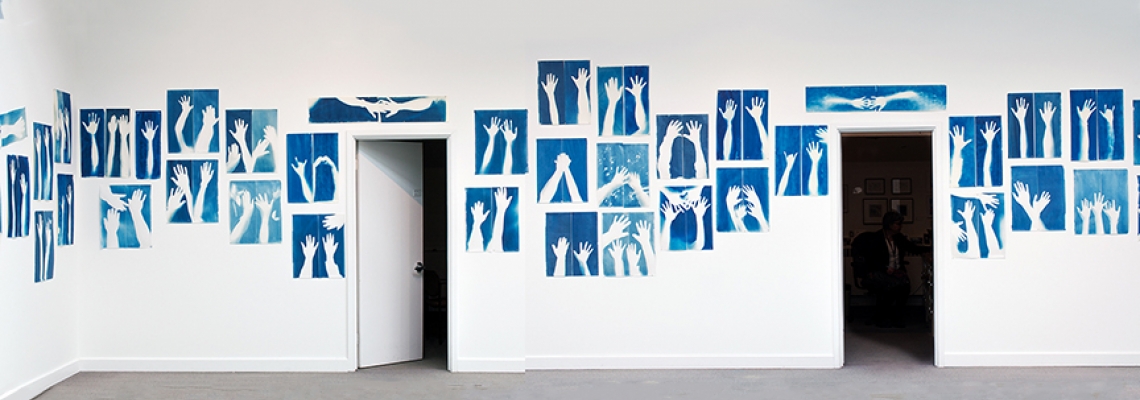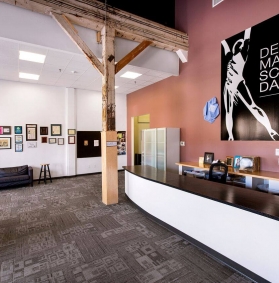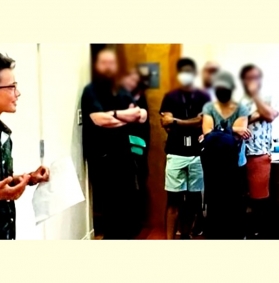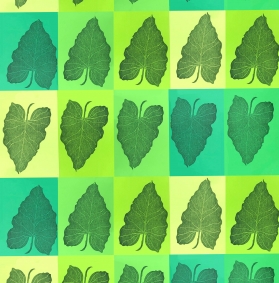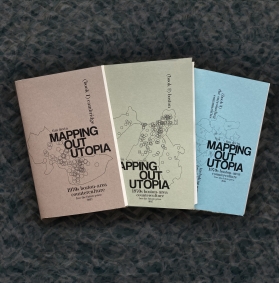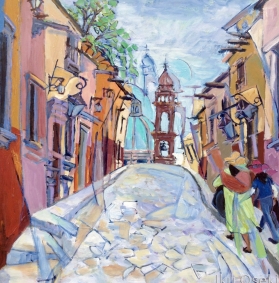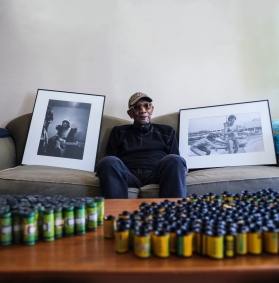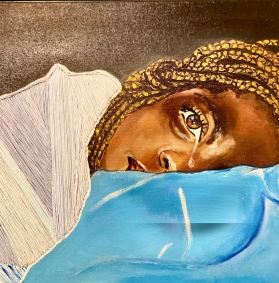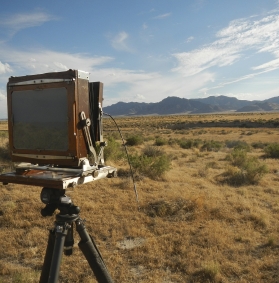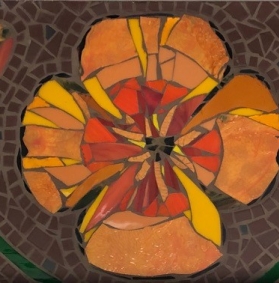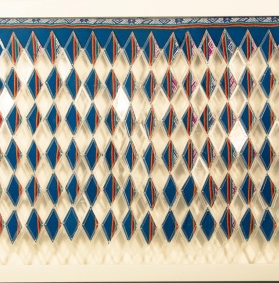June Artist of the Month Edie Bresler, interviewed by Kerrie Kemperman

How and when did you get into photography?
My dad and two uncles were all avid picture takers so that piqued my curiosity about cameras at an early age. When I was 13, I got my first camera and took that K1000 all across the north and south forks of Long Island on my bike. One of my uncles had a darkroom in his basement and that’s where I first learned how to develop film and make prints. My father was also meticulous with our family photo albums and I remember many nights scrutinizing the faces of my ancestors in prints from the late 1800s that my grandparents brought with them to this country. The same year I turned 13, my mother was diagnosed with ALS so being outside with my camera became how I coped with all the changes at home.
What drew you to alternative processes? (Perhaps add some basic background about the process you’ve explored most).
I started experimenting with alternative photographic approaches in the 1980s. While a student at the School of Visual Arts, my side hustle was matting portfolios for galleries on the upper east side and installing exhibitions downtown in Soho. Living in NYC in the 1980s was such a creative juggernaut and I was exposed (haha, pun intended) to so many new ways of being expressive and making art. That was when I started thinking intentionally about how to make photographs that defied traditional norms by not looking like photographs. Back then I was making elaborate room constructions from the single point of view of my 4x5 lens. After staging found objects around hand-painted floorboards, walls, and window panes, I photographed the life-size set including the city outside my studio windows. Pressing the camera shutter compressed everything into a single layer so I was inventing imaginary worlds without any post-production tools like Photoshop. Making cyanotypes is an extension of these same ideas and impulses.
thinking intentionally about how to make photographs that defied traditional norms by not looking like photographs. Back then I was making elaborate room constructions from the single point of view of my 4x5 lens. After staging found objects around hand-painted floorboards, walls, and window panes, I photographed the life-size set including the city outside my studio windows. Pressing the camera shutter compressed everything into a single layer so I was inventing imaginary worlds without any post-production tools like Photoshop. Making cyanotypes is an extension of these same ideas and impulses.
In 2017 I began making cyanotypes in earnest for my third participatory photography project. I knew I wanted to collaborate with random passersby again but was seeking to make something besides traditional portraits. Cyanotypes create a unique one-to-one light drawing of whatever is in contact with the emulsion against varying shades of cerulean blue. The process is portable, uses sunlight for the exposure and develops permanently in water. All that summer and early fall, I walked around Somerville, Cambridge, and Boston with my light-tight packages containing sheets of vellum hand coated with the cyanotype emulsion. I would ask random passersby to ‘pose’ for a cyanotype portrait and by October, I had 134 unique prints of outstretched hands and arms. When the cyanotypes of all these people who said “yes” are installed together they represent a sea of possibility, going against the tide of hate and mistrust currently dividing us.
and by October, I had 134 unique prints of outstretched hands and arms. When the cyanotypes of all these people who said “yes” are installed together they represent a sea of possibility, going against the tide of hate and mistrust currently dividing us.
What excites you about cyanotypes now? Are you still discovering new aspects to the process or are you pulled into your work by the themes you explore?
My favorite part of the cyanotype process is not knowing how the photograph will turn out. I may have ideas and an agenda for layering people and/or objects and how long to expose them in sunlight, but the outcome is always surprising. I find beauty in letting go of control and inviting randomness into the creative process. During the lockdown of spring and summer 2020, I made a ton of cyanotypes. I even got my students at Simmons (where I teach and direct the photo program) involved with making them at home by shipping them chemistry and developing trays. The simplicity and surprise enlivens the present in a healing way we all very much still need.
and inviting randomness into the creative process. During the lockdown of spring and summer 2020, I made a ton of cyanotypes. I even got my students at Simmons (where I teach and direct the photo program) involved with making them at home by shipping them chemistry and developing trays. The simplicity and surprise enlivens the present in a healing way we all very much still need.
To answer the second part of your question, I think the relationship between process and ideas is very symbiotic. I’ll give you an example: last summer, I began thinking about a new series of Cyanotypes focusing on the idea of nature versus plastic. After experimenting with different objects and exposure times, I simplified things by choosing two distinct players in this ongoing environmental battle: samara seeds and power cords. Samara seeds are those helicopter-like pods that fall from maple and ash trees in the spring and we all have so many necessary and obsolete power cords filling our homes and landfills alike. My cyanotypes are like imaginary battle scenes where the seeds float and dance across multi-panel pages pursued by the snake-like cords, which threaten their existence. Each time I make a new piece it influences the original idea with new possibilities.
What particular influences or interests inspire or direct your creative work?
I enjoy experimenting just to see if something will or can work so taking chances and being open to new ideas is a big part of my creative process. I am also inspired by the work itself, meaning [that] just making photographs is inspiring for me. Whether I am using film, digital files, or alternative processes, I love this medium.
process. I am also inspired by the work itself, meaning [that] just making photographs is inspiring for me. Whether I am using film, digital files, or alternative processes, I love this medium.
I am likewise inspired by other artists, curators, and [am] especially happy to be back looking at art in galleries and museums. I recommend making time to visit White Shadows: Anneliese Hager and the Camera-less Photograph at the Harvard Art Museum (on view till July) and am looking forward to seeing the Philip Guston show, which recently opened at the MFA. Reading fiction and non-fiction is another valuable part of my practice and keeps me going through the rough patches.
How long have you lived in Somerville and what brought you to the area?
I was 5 months pregnant with my son when I moved to Somerville during the blizzard of April 1, 1997. I had been traveling back and forth between Boston and NYC, but as parenthood approached I opted to move permanently to a quieter, more manageable city. I was drawn to Davis Square because of its close proximity to the T, a movie theater, live music (the sadly departed Johnny D’s), a public library, bookstores, and the bike path. It was really important for me that I was not depending on a car to get around town. I love being able to walk or bike locally for last-minute ingredients and I am so grateful to have multiple ways of commuting to work. It’s hard to believe I marked a 25-year anniversary in my Somerville home this past April.
forth between Boston and NYC, but as parenthood approached I opted to move permanently to a quieter, more manageable city. I was drawn to Davis Square because of its close proximity to the T, a movie theater, live music (the sadly departed Johnny D’s), a public library, bookstores, and the bike path. It was really important for me that I was not depending on a car to get around town. I love being able to walk or bike locally for last-minute ingredients and I am so grateful to have multiple ways of commuting to work. It’s hard to believe I marked a 25-year anniversary in my Somerville home this past April.
What are your favorite spots in Somerville?
As a voracious reader, I love the public libraries, and have been a dedicated library patron all my life. I also like to take a walk or bike to different neighborhoods across Somerville. I enjoy seeing people’s gardens take shape and if someone is not gazing at their phone, I like saying hi and engaging with people. I am a big fan of all the new bike lanes in Somerville and regularly attend the annual Honk and Art Beat festivals.
Because of food allergies, I can’t eat out much, but I can and do indulge periodically at Sugidama in Davis Square. I like to check out the evolving merchandise at D2 [Davis Squared] and peruse the bins at Comicazi. Finally, I am indebted to programs like Project Soup, where I was fortunate to volunteer during the pandemic. Like a lot of us I was teaching remotely from home, so that unused commuting time was an opportunity to help out with this incredible local organization. Every week I packed up and handed out boxes of fresh fruit, vegetables, and other necessary food staples to families across the community. I learned that Project Soup serves 900 Somerville families every month. Volunteering is a great way to be more connected to our Somerville communities.
How would you describe your work/life balance, or how do you balance your creative time with the pressures of making a living?
That’s such a good and tough question. Because I’ve been making photographs for so long, I’m pretty hardwired for juggling and finding balance. Having goals to show finished work or projects is especially helpful so I encourage struggling artists to join a critique group that meets regularly. Sometimes just being in conversation with other like-minded photo enthusiasts forces you to finish a project. This is the best way to achieve a more effective work/life balance.
I am fortunate that my teaching work is focused on the language of photography. What and how I teach informs my studio practice in rich and unforeseen ways. I am grateful for all the ways my students challenge me to think differently about the relationship between photography, meaning, and time. I have been having this conversation for over fifty years! Keeping my focus on the joy I derive from being engaged with art, photography, and meaning alleviates the constant pressures of paying the bills. And when all else fails, I go hiking in the Fells with friends or head out for a long bike ride.
Please share links to your website, Instagram, or other social media if you would like to promote them. Where are you teaching this summer? Any upcoming workshops?
www.ediebresler.com
Instagram @ediephoto
This summer I’m taking a much needed hiatus from teaching and workshops to recharge from the past two years of teaching through the pandemic. Lots of studio plans will be balanced with many outdoor adventures.
This fall I will be leading a monthly critique group for The Griffin Museum of Photography.
The group is for photo enthusiasts at any level who are seeking to jumpstart their creativity
or push past creative blocks in their photo-based projects.
Feel free to drop me an email ([email protected]) if you’re interested and
I will be sure to send you a link to registration details when it becomes available.
